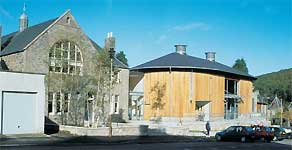Timber cladding in Scotland
The study outlines the development of timber cladding in Scotland, describes timber clad buildings in Scotland, and provides practical information on the use of timber cladding in Scotland.
Timber Cladding in Scotland
WESTERN RED CEDAR
CASE STUDY
BIRNAM INSTITUTE, BIRNAM, PERTHSHIRE
MACMON ARCHITECTS
|
The use of timber on the new extension to the Birnam Institute contrasts well with the prevailing stone and slate Victorian architecture of the small town and of the Institute itself. The original building has been owned and managed by the Birnam Institute for more than 100 years, providing the community with a hall and a lending library, and a fully glazed, double height 'link' now connects it with the new facilities. A new foyer and cafe, multi-purpose hall, arts' workshops and mezzanine gallery have been created. There are very few standard details or wall conditions to the new building: it has a steel frame, with timber frame infill forming the inner leaf and supporting sheathing ply and membranes (at one stage the architects considered a specification utilising breathing wall principles, but the construction's complexity and discontinuity mitigated against this). The support framework for the timber cladding is formed from 38 x 38 mm battens and counterbattens, with the vertical western red cedar (class 1 to BS1186 - 3: 1990) curved around the radiused ends of the new block. The timber has not been coated in any way as it is intended that it should progressively weather to a silver-grey colour. |
The tongue and grooved ex 135 x 25mm vertical boards are twice nailed at approx 600 centres, with one secret fixing and one face-fixed. Having consulted with TRADA and followed the recommendations in its Cladding Manual, the architects used a TRADA nail-fixing specification. The contractor offered an alternative 'brad nail' specification (as proposed by their nail gun supplier) which offered equal performance, pull out strengths etc, but nevertheless considerable time was expended by all parties on this issue as there were concerns about the possibility of the boards splitting and on the visibility of the nail heads.
Once commenced, however, the application and fixing proved to be relatively straightforward, although the radiused plan did cause some problems in respect of the groove width 'opening up', and the architects chose to reverse the boards to achieve their visual preferences. The work was carried out on a less-controlled basis than they would have liked and in future they intend to include a requirement within their specifications for early stage samples of workmanship.

Peter Wilson
Contact
Email: Central Enquiries Unit ceu@gov.scot
There is a problem
Thanks for your feedback
